 |
Scientific nameCryptochaetum sp. nr. iceryae (Williston)
Taxonomic positionDiptera: Brachycera: Cyclorrhapha: Cryptochaetidae
DiagnosisBody size small, about 2 mm. Dark metallic blue / bluish green fly with dark red, elongate eyes. Antenna three-segmented, terminal segment greatly enlarged with a short, stout, terminal spine, lacking an arista, reaching almost to lower margin of eyes. Parasitic on Icerya spp. and other
margarodids (Hemiptera: Margarodidae).
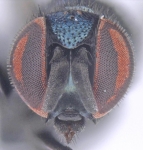
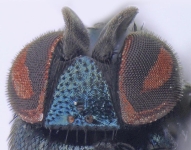 Head, Head - dorsal view Head, Head - dorsal view
Images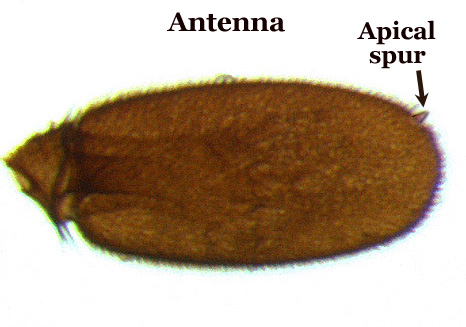 Apical spine on antenna Apical spine on antenna
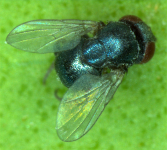 Adult fly, dorsal view Adult fly, dorsal view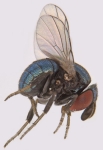
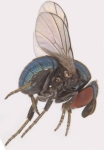 Adult fly, lateral view Adult fly, lateral view
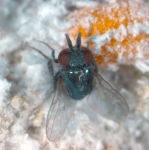 Adult fly in Icerya colony Adult fly in Icerya colony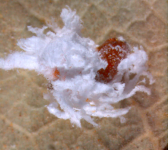 Pupa of Cryptochaetum sp. Pupa of Cryptochaetum sp.
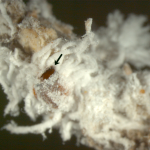 Emergence hole on dead Icerya sp. Emergence hole on dead Icerya sp.
DistributionCryptochaetum grandicorne is indigenous to India and parasitic on Icerya purchasi, I. aegyptiaca, I. seychellarum, I. pilosa and Labioproctus sp. C. iceryae was introduced from Australia in several countries where the Vedalia beetle was introduced. It was introduced in India from California, USA, in 1947 and 1948, but apparently did not establish (Subramanyam, 1949).
Hosts / BiologyLarvae are parasitic on Icerya spp. and other margarodid scales (Hemiptera:
Margarodidae). Cryptochaetum iceryae is an effective natural enemy of Icerya spp. and was introduced in the US in 1888, before the introduction of the famous Vedalia beetle. This fly is reported to be even more efficient than Rodolia cardinalis against cottony cushion scale.
It is an apneustic endoparasitoid, i.e., the spiracles of the parasite remain closed and non-functional until larvae mature and are ready to leave the host. Until that time, the parasite is strictly dependent upon cuticular diffusion of oxygen, either dissolved or gaseous, from host oxygen supplies. The larva of Cryptochaetum iceryae possesses two long caudal filaments containing tracheae, which become entangled with the tracheae of its host. Atmospheric oxygen diffuses from the host tracheae into the tracheae contained in the caudal filaments of the parasite (Thorpe, 1930). The fly deposits one to four eggs inside each third-instar or adult female scale. The larvae feed within the scale and moult four times before they pupate. The oblong pupal case may remain inside the scale or appear outside the dead scale, leaving one or more round emergence holes. The pupae are dull brown to orangish when they first emerge from scale egg sacs and become dark before adult emergence. The life cycle of the is about 4 weeks in warm weather. References
|
